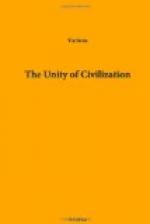What then of Religion? How far were the older ethnologists on the right lines, when (in spite of language, rather than aided by it) they co-ordinated their own Olympus with the confederate polytheisms of the North? Here, too, we have to keep the dates in mind, and clear ourselves of enthusiasms. It is not from Tacitus or Caesar, nor even so near to the Olympians’ dwelling-place as the Thrace of Herodotus’ time, that we get our modern impression of the nearness of Olympus to Asgard. If northern genealogies are any guide,—and they are not likely to have reduced the real interval wittingly—Rome’s empire reached its full extent while Asgard was in building, or before. And Olympus was in building, by Greek accounts, not many generations before the Trojan War. In both cases we are dealing with political and almost historical transactions; it was not in finished societies like these that Great Gods (or their votaries either) set out from ‘home’ over the face of Europe to unite it.
And when we pass behind Olympian structures, and look into the cults which they served to federate, such uniformities as they present prove far too much. The open-air gods of Tacitus (Germania, chap. 9) are common to Semitic folk, and to many peoples further afield, who are either not sedentary or are themselves not easily ’confined within walls’, but haunt ‘forests and groves’.
Leaving, then, these high works of the mind, Language and Religion, which have proved but blind guides, and ‘of a short stay’ in this labyrinth, let us turn to the material evidence of industrial and aesthetic activity. Here we begin at least to get something like first-hand evidence, for we have the manufactured object itself, not Caesar’s impression of a Celtic god, or Herodotus’ transcript of a Scythian word. We can judge for ourselves of fabrics and styles, and though, of course, we have only objects of the least perishable sorts, stone, metal, pottery, we have, at all events, in the pottery the most imitative of arts, and therefore the widest basis for conclusions as to the principles of a style. Moreover, outside the sea-borne culture of the Mediterranean, pottery does not travel far: its uses are domestic, not commercial. John Gilpin’s fate is typical of those who would carry things on horseback in bottles. Like words, however, potsherds enlighten us more about frontiers and contrasts than about uniformities. They are terribly provincial and tell their tale with a twang. We can trace our Bandkeramik and Schnurkeramik and Urfirnissmalerei and all that sort of technological idiom, across the map, as we can trace the centum and satem languages. But even if we could collate the ‘Bandkeramiker’ with the ‘Satemvoelker’ as recent enthusiasts propose, we should be no nearer to a common technology for Europe than we were to a common language.




